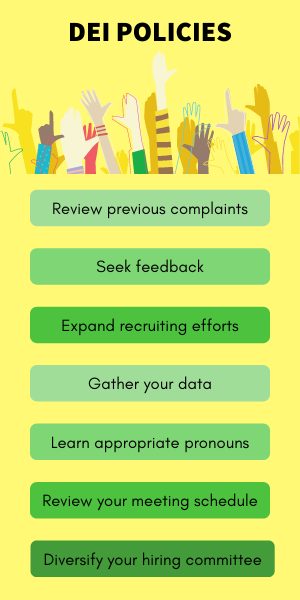7 DEI policies you can implement in your workplace today
 Improving diversity, equity, and inclusion policies within your company might feel overwhelming at the onset, especially if you know you have a long way to go. However, no matter your starting point, consistent efforts are crucial to improved DEI and overall company performance.
Improving diversity, equity, and inclusion policies within your company might feel overwhelming at the onset, especially if you know you have a long way to go. However, no matter your starting point, consistent efforts are crucial to improved DEI and overall company performance.
A more inclusive workplace improves productivity, retention, and much more. That’s why it’s vital not to be paralyzed by the size of the overall task, but to start making positive changes in your organization as soon as possible.
To have the greatest impact, you should have both long and short-term plans in place. Large sweeping changes are necessary, but don’t forget about the little steps you can make immediately to start seeing improvements as you embark on your DEI journey. Consider these 7 tasks that you can get started with today as you build out your larger plan.
Review previous complaints
Employees submit complaints in hopes that a thorough investigation into the incident will occur. However, if investigating staff underestimated the complaint due to its nature, previous incidents might have been swept under the rug unnecessarily. Take a look back at previously submitted discrimination complaints from your new DEI lense. Review the notes to ensure there was a fair and thorough investigation into the occurrences.
If the situation requires a new investigation, do so promptly. Also, to expand upon this, remind staff that all discrimination complaints are taken seriously and to contact human resources for a prompt, thorough and serious investigation into the matter.
Today: Review previous discrimination complaints and release a memo that staff should report any discriminatory acts immediately for review.
Seek feedback
Your staff is your lifeline to what’s occurring within the company. While they will often discuss amongst themselves or keep their feelings private regarding changes they’d like to see company-wide, you want them to communicate their thoughts with you. In opening the lines of communication with the staff, you’re able to identify blind spots you might have typically overlooked.
Also, be sure to solicit feedback from everyone, not just pockets of the staff, and be transparent regarding your desire to improve.
Finally, ensure they can provide their feedback in a safe space. This might not be a conversation best had in person or with identifying information attached to the feedback, and that’s okay. The purpose is to get the information in a way that makes staff feel comfortable sharing.
Today: Create a survey or develop a method to collect feedback from staff regarding their feelings related to DEI within the company.
Expand recruiting efforts
Securing a DEI-friendly work environment includes your recruiting efforts. If you want more diverse talent in the company, it might require that you specifically seek out recruitment efforts that include those demographics. When you go where the diverse staff is, you’re more likely to find them. It’s time to stop relying on your go-to recruiting methods and start stepping outside the box to find your staff.
Today: Identify community organizations, schools, professional associations, conferences, and job recruitment fairs that are likely to attract the talent you’re seeking.
Gather your data
The first step in developing a DEI plan is to know where you’re starting as an organization. That begins by gathering your data. Having this quantitative data can give you a starting point to track over time as you implement your plan and start achieving your DEI-related goals.
Gather data related to:
- The overall makeup of your organization
- The makeup of your organization at different levels (i.e., upper management, middle management, administrative)
- The recent hires
- The hiring pool
- The recent promotions
- The salary of staff members and more.
Today: Make a list of the data you want to gather and the process you need to take to collect it.
Learn appropriate pronouns
By allowing staff to select their appropriate pronoun, you empower them to go by their identity in the workplace which can take a significant weight off their shoulders. Request an updated employee profile for current employees that includes gender identity and use the requested pronoun consistently. For new employees, you can ask them in their onboarding information. Until you’re sure how an employee identifies themselves, you can use a neutral and more inclusive pronoun like “they” or “them.”
Today: Determine how you will collect appropriate pronouns from current and new employees.
Review your meeting schedule
As your workforce continues to diversify, keep in mind the time of the company events you schedule. Employees with families, single parents, caregivers of elderly parents, or even those working a part-time job might struggle to attend after-work meetings.
Consider trying to schedule meetings during work hours so the time can accommodate more people’s schedules. To do this you can schedule meetings over lunch or end the workday a bit earlier. Instead of assuming the best time to hold meetings, poll your staff to see if the current schedule is working or if a change might be welcome.
Today: Review your meeting schedule and seek input from employees regarding meeting time preferences.
Develop a diverse hiring committee
Having a diverse hiring committee in place will increase the likelihood of more diversity, equity, and inclusion in the hiring selection process. Also, part of a more DEI-friendly hiring process is clarifying how you assess applicants based on job-related qualifications. This might require training on how to prevent internal bias from impacting hiring decisions as well.
Today: Review your current hiring committee and criteria for hiring employees.







